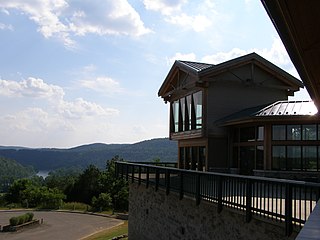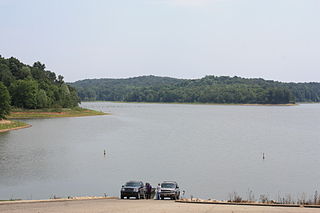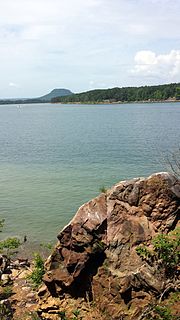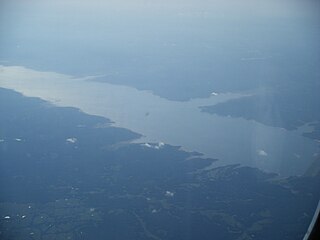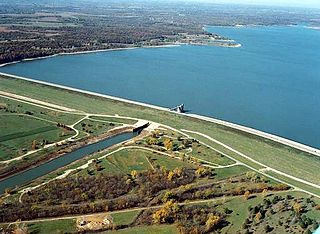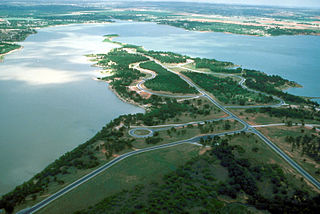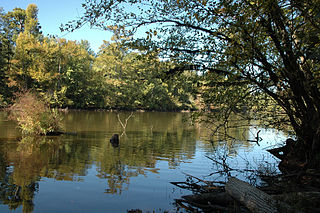| Millwood State Park | |
| Arkansas state park | |
| Country | United States |
|---|---|
| State | Arkansas |
| Regions | South Arkansas |
| County | Little River |
| City | Ashdown |
| Coordinates | 33°40′39″N93°59′14″W / 33.67750°N 93.98722°W Coordinates: 33°40′39″N93°59′14″W / 33.67750°N 93.98722°W |
| Opened | April 1, 1976 |
| Management | Arkansas Department of Parks and Tourism |
| Website: Millwood Lake State Park | |
Millwood State Park is located just outside Ashdown, Arkansas, in Little River County in southwest Arkansas. Known for its excellent fishing and wildlife habitats, [1] [2] the park was established about a decade after the U.S. Army Corps of Engineers built 29,500-acre Millwood Lake north of Texarkana in Miller County. Held in place by a 3.3-mile-long earthen dam (the longest of its type in Arkansas), the lake’s trademark timber stands have made it a bass-fishing haven by providing cover vegetation and a food source that keep the fish in shallow, more accessible water.

Ashdown is a city in Little River County, Arkansas, United States. The community was incorporated in 1892 and has been the county seat since 1906. Located within the Arkansas Timberlands between the Little River and the Red River, Ashdown's economy and development have historically been tied to the timber industry, a trend that continues to this day. Ashdown's population at the 2010 census was 4,723, a slight decrease from the 2000 census. The city's well-preserved history and proximity to outdoor recreation such as Millwood State Park draws tourists to the area. Although not within the Texarkana metropolitan area, the city's proximity to Texarkana impacts many areas of life in Ashdown.

Little River County is a county located on the southwest border of the U.S. state of Arkansas, bordering a corner with Texas and Oklahoma. As of the 2010 census, the population was 13,171. The county seat is Ashdown.

Arkansas is a state in the southern region of the United States, home to over 3 million people as of 2018. Its name is of Siouan derivation from the language of the Osage denoting their related kin, the Quapaw Indians. The state's diverse geography ranges from the mountainous regions of the Ozark and the Ouachita Mountains, which make up the U.S. Interior Highlands, to the densely forested land in the south known as the Arkansas Timberlands, to the eastern lowlands along the Mississippi River and the Arkansas Delta.
The lake was built in 1966 on the Little River, some sixteen miles above its confluence with the Red River. In addition to the Little River, the Cossatot and Saline rivers also contribute to the lake.
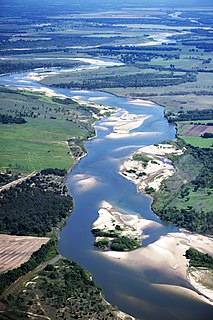
The Red River, or sometimes the Red River of the South, is a major river in the southern United States of America. It was named for the red-bed country of its watershed. It is one of several rivers with that name. Although it was once a tributary of the Mississippi River, the Red River is now a tributary of the Atchafalaya River, a distributary of the Mississippi that flows separately into the Gulf of Mexico. It is connected to the Mississippi River by the Old River Control Structure.

The Cossatot River is an 89-mile-long (143 km) river in Howard, Polk and Sevier counties in the U.S. state of Arkansas.
Among several recreational areas the Corps of Engineers established on the lake’s shoreline was Cypress Slough, at the southwestern end of Millwood Dam. On April 1, 1976, the Corps signed a lease agreement with the State Parks Division of the Arkansas Department of Parks and Tourism, and Cypress Slough became Millwood State Park. The site was chosen because of the important role the various lakes in the Little Red River basin play in controlling flooding on the Red River below Lake Texoma.

Lake Texoma is one of the largest reservoirs in the United States, the 12th largest US Army Corps of Engineers' (USACE) lake, and the largest in USACE Tulsa District. Lake Texoma is formed by Denison Dam on the Red River in Bryan County, Oklahoma, and Grayson County, Texas, about 726 miles (1,168 km) upstream from the mouth of the river. It is located at the confluence of the Red and Washita Rivers. The project was completed in 1944. The damsite is about 5 miles (8.0 km) northwest of Denison, Texas, and 15 miles (24 km) southwest of Durant, Oklahoma. Lake Texoma is the most developed and most popular lake within the USACE Tulsa District, attracting around 6 million visitors a year. Oklahoma has more of the lake within its boundaries than Texas.
Due to the Corps of Engineers’ involvement, a combination of state and federal funds was used to expand the park’s facilities. Additional funding over the years has greatly improved the park. The lake and park take the name “Millwood” from a frontier river landing in the area, which was in use between 1845 and 1875.
The park offers camping, picnic sites, a pavilion, a marina, boat rentals, and hiking and bike trails. The park hosts several recreational events and interpretive activities, including fishing events, bird watching, lake tours, and family festivities.


